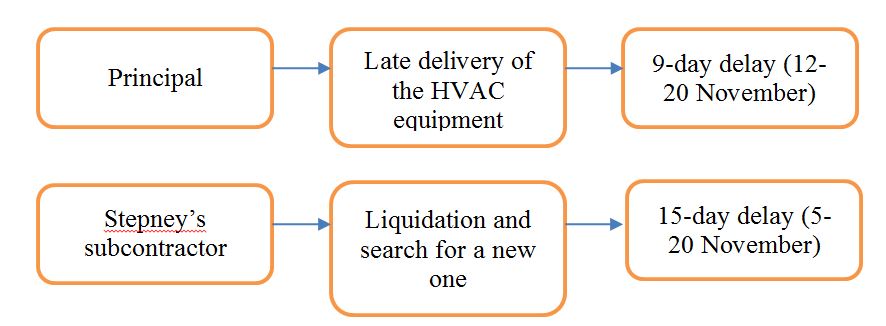Since issues with evicting squatters resulted in the fact that Parkes, the Principal, did not hand possession of the site over to Stepney, the Contractor, until 6 March 2019, the Contractor is entitled to remedies. Clause 1(a) stipulates that “any act, default, or omission by the Principal” is a qualifying cause of delay. Thus, the late possession handover denotes that the Principal violated an implied obligation to make the site available and accessible for the Contractor (MinterEllison, no date a, para. 1). Consequently, the Contractor can request an extension of time (EOT) for 22 days between 12 February, when Stepney’s tender was accepted, and 6 March. Furthermore, Clause 34.9 stipulates that delay damage is payable to the Contractor of $8,000 per day, resulting in $176,000. This narrative demonstrates that the practical completion date may occur 22 days later.
EOT Claim Entitlement
The Architect’s late delivery of roof details resulted in four days of delay, and the Contractor asked for three days of EOT. Stepney is not likely to be entitled to the EOT under the contract. The rationale is that Clause 34.3 (b) specifies that no extension is possible if the Contractor fails to submit a written claim within 14 days of the delay occurring. The roof details were supplied on 27 September, while the Contactor filed an EOT claim on 14 October, which denotes that the allowed date was exceeded.
An EOT claim should be rejected irrespective of the fact that the Contractor mentions Clause 41.2 of AS 4000, stating that late submissions should not be barred. However, this condition is not applied to the case because Clause 41.2 was deleted from the contract. Furthermore, a decision in Growthbuilt Pty Ltd v Modern Touch Marble & Granite Pty Ltd (2021) demonstrates that an EOT can be granted as a matter of discretion, but it is not an obligation. Since Modern Touch Marble & Granite Pty Ltd failed to file an EOT claim duly and on time, Growthbuilt Pty Ltd was not obliged to grant an EOT. That is why this information indicates that Stepney is not entitled to a time extension.
Inclement Weather
Since there are ten hot days during January 2020 and the enterprise bargaining agreement stipulates that workers should leave the site under these conditions, it is reasonable that Stepney submits an EOT claim. However, this claim will likely be rejected, and the rationale is that Clause 1(d) mentions that inclement weather is not considered a qualifying reason for delay. This information means that even though the EOT claim was duly filed, the extension is not allowed under the contract.
Number of Days EOT for Stepney
Two issues resulted in the overlapping delay, and the diagram below reveals it.

This diagram demonstrates that Stepney dealt with a concurrent delay on the period 12-20 November. A suitable decision in such cases is to apportion causes of delay between the parties (MinterEllison, no date b, para. 16). On the one hand, the Principal’s failure to supply the HVAC equipment in time caused a 9-day delay. Clause 1(a) stipulates that this condition is a qualifying reason because the Principal’s failure contributed to the problem. On the other hand, the liquidation of Mech Install Pty Ltd and the further search for a new subcontractor do not lead to an extension. Clause 1(a) specifies that if a delay occurs because of firms employed by the Contractor, it is not a qualifying cause. Even though there is an overlap, Stepney is only entitled to a 9-day EOP.
Delay Damages
The analysis above allows for calculating the total amount of delay damages to which Stepney is entitled if all the EOT claims have been duly filed. Geddes (2021, para. 5) explains that these damages typically arise from the Principal’s failures. Clause 1(a) clarifies that the issues with evicting squatters led to a 22-day EOT. If an EOT claim had been filed on time, Clause 34.3 (b) would not have been applied to late delivery of roof details, and Stepney would have been entitled to a 3-day extension. While inclement weather cannot lead to delay damages, Clause 1(a) denotes that a 9-day EOT should be implied because the Principal failed to deliver the HVAC equipment in time. Consequently, Stepney is entitled to a 34-day EOT that is equal to $272,000 (34*$8,000 per day).
Liquidated Damages
Simultaneously, it is reasonable to comment on liquidated damages that are payable from Stepney to Parkes. Nay (2021, para. 2) explains that these damages are the amount of money that a contractor pays if they fail to complete the works on time. A contract should typically have a fixed amount of liquidated damages (Nay, 2021, para. 5). Clause 1(d) means that the case with inclement weather resulted in a 10-day delay, while the issues with Stepney’s subcontractor resulted in 6 days of delay under Clause 1(a) because the overlap led to a 9-day EOT. Consequently, Stepney is obliged to compensate for 16 days, but the exact amount is not stipulated in the contract. If the formula to calculate liquidated damages is the same as for delay damages, Parkes owes $272,000 (34*$8,000 per day) to Stepney, while Stepney owes $128,000 (16*$8,000 per day) to Parkes.
Reference List
Geddes, H. (2021) Liquidated damages vs delay damages: what is the difference? Web.
Growthbuilt Pty Ltd v Modern Touch Marble & Granite Pty Ltd (2021) NSWSC 290.
MinterEllison (no date a) Chapter 6 accessing the site. Web.
MinterEllison (no date b) Chapter 11 extension of time regimes. Web.
Nay, R. (2021) What are liquidated damages in construction contracts? Web.